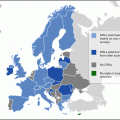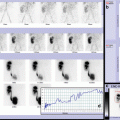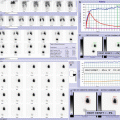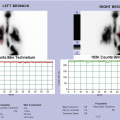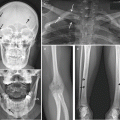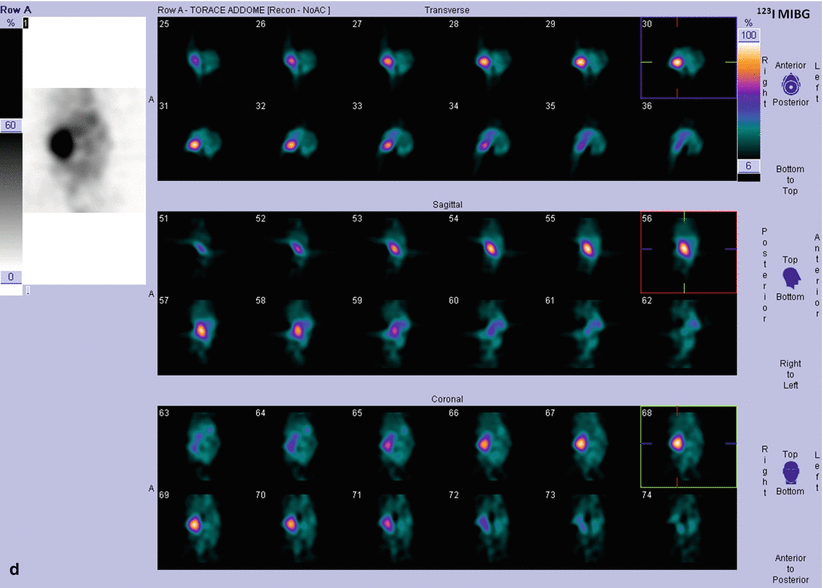
Fig. 13.1
(a, b) Ultrasonographic images detect a large, oval, “comma”-shaped suprarenal mass showing an echoic fine nonhomogeneous pattern; neither calcifications nor necrotic areas are seen within the lesion. Diameters are about 40 × 27.5 × 34.5 mm. Right kidney is displaced and distorted, but not infiltrated by the tumor, and adrenal flaps are opened wide; a “contact” is present between the mass and the inferior vena cava that appears “flattened,” reduced in diameter in retrohepatic tract, but with partially visible lumen. Color-Doppler ultrasound (CDUS) evaluation shows some flow signal peripherally and within the lesion. (c, d) MIBG scintigraphy (static views (c) show an area of intense and nonhomogeneous radiotracer uptake in the abdomen, corresponding to the mass detected by ultrasonography; no other areas of pathological uptake of radiotracer are evident. SPECT images (d) help to better identify the site of the uptake (right adrenal region)
13.2.2 Case 13.2 Prenatal Diagnosis of Adrenal Mass: Nonavid Lesion at MIBG Scan
A newborn with prenatal diagnosis of left adrenal mass undergoes at birth an ultrasonography (Fig. 13.2a–d), which shows a reduction of diameters of the lesion; therefore, 123I-MIBG scintigraphy is performed in order to exclude a NB (Fig. 13.2e, f). The lesion appears as nonavid of MIBG, and the baby is enrolled in observational protocol for neonatal adrenal mass.
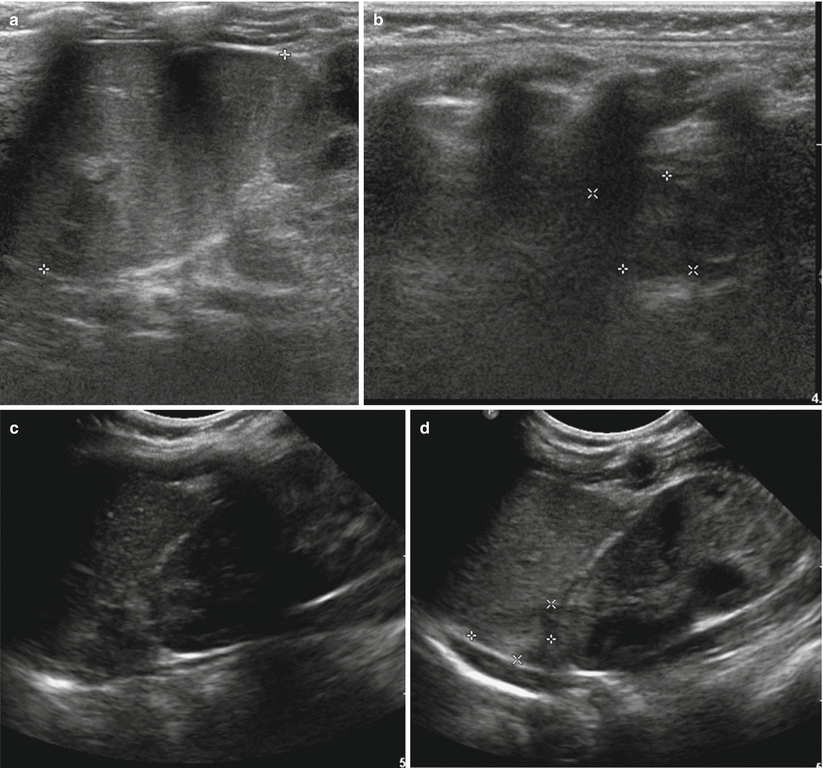
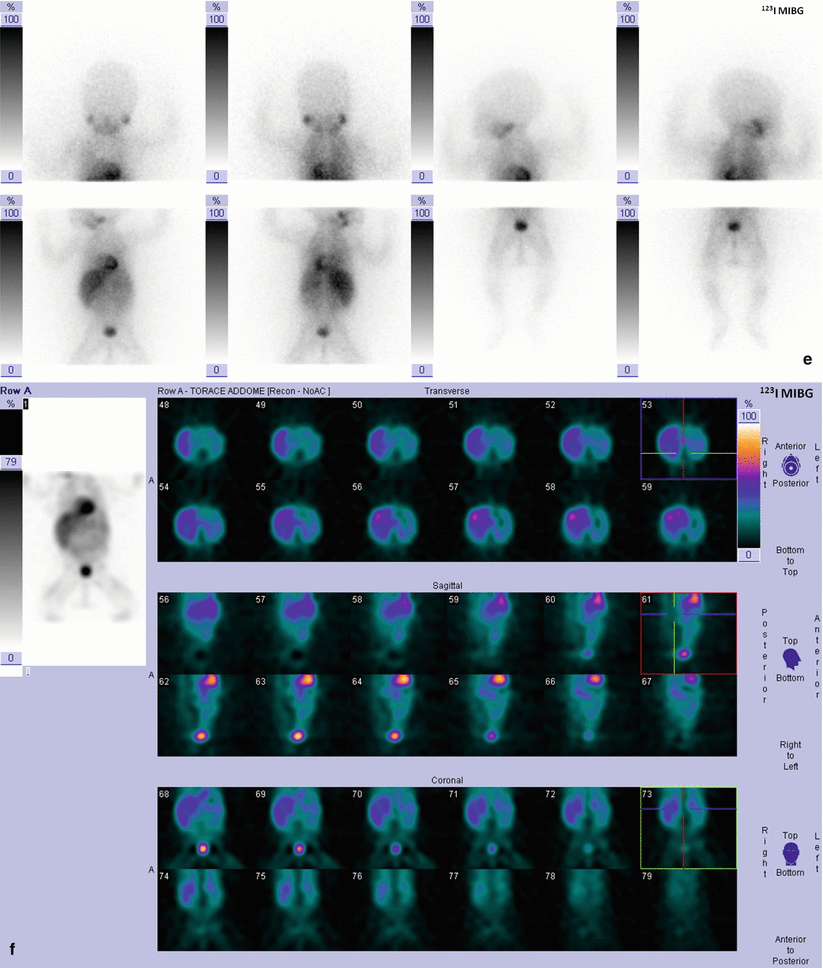


Fig. 13.2
(a–d) Ultrasonographic images of the left hypochondrium shows a lesion with size reduced compared to the previous ultrasound examination performed in gestational age (now measuring about 14 × 12 × 10 mm). This lesion presents another homogeneous pattern, mainly hypoechoic with tiny hyperechoic spots in the central part, probably due to small calcifications. At CDUS, no flow signals are detected within the adrenal mass. Spleen and left kidney are separated from the lesion by a fatty layer. (e, f) MIBG scintigraphy (static views, c) does not show any areas of pathological uptake of radiotracer; in particular, the lesion detected by ultrasonography appears as nonavid of MIBG. SPECT images (f) confirm this finding
Lesion was no longer detectable at ultrasonography performed at 1 year of age.
13.2.3 Case 13.3: MIBG Scintigraphy in Localized Thoracic Neuroblastoma Infiltrating Spinal Canal
An 11-month-old baby presents sudden hypotonia and difficulty in crawling; physical examination confirms hypotonia of the lower limbs. Suspecting a spinal cord compression, a brain and spine magnetic resonance (MR) (Fig. 13.3a–d) and a chest and abdomen computed tomography (CT) (Fig. 13.3e,f) are performed, and a left mediastinal mass is detected localized at the costovertebral junction between the T1 and T6 spinal levels, with foraminal and intraspinal extension. Histological examination shows a stroma-poor NB, and, subsequently, a MIBG scintigraphy for staging purpose is scheduled and confirms the presence of the mass without metastases (Fig. 13.3g, h). Genomic profile shows absence of numerical chromosomal aberration, and so the case is defined as L2 neuroblastoma <12 months of age at diagnosis with IDRFs – NCA genomic profile with life-threatening symptoms. Patient is enrolled in LINES protocol – Group 2, and underwent chemotherapy. After receiving two courses of chemotherapy with carboplatin and etoposide, a complete resolution of symptoms is observed. A re-evaluation of disease shows the persistence of IDRFs; so, patient undergoes follow-up.
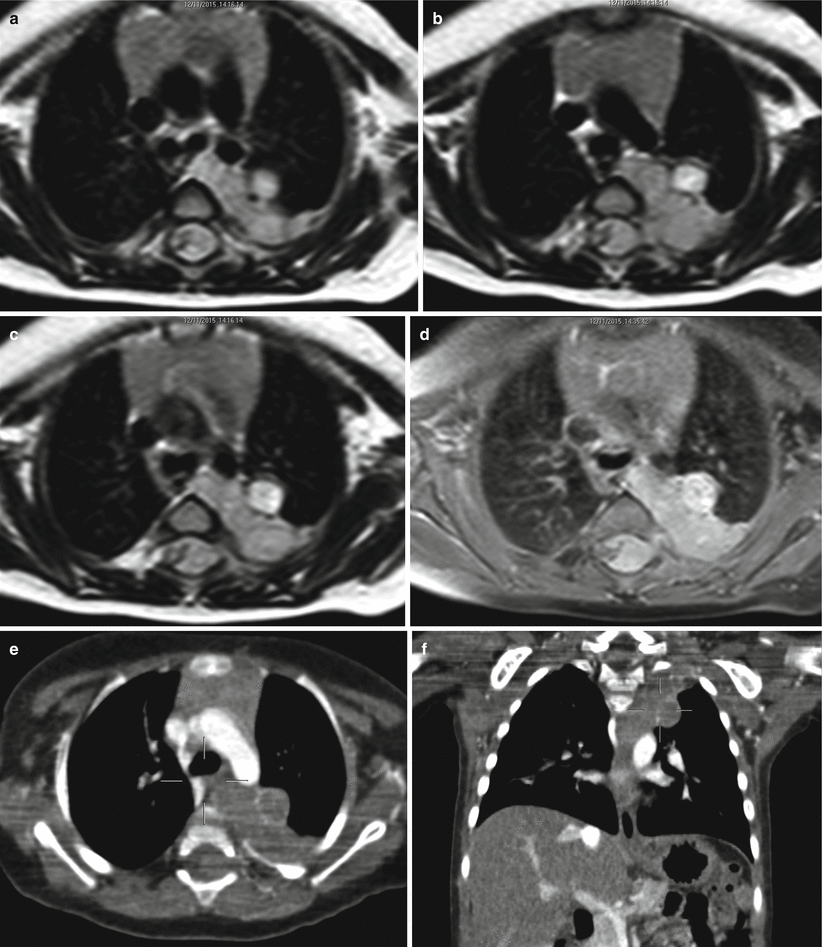
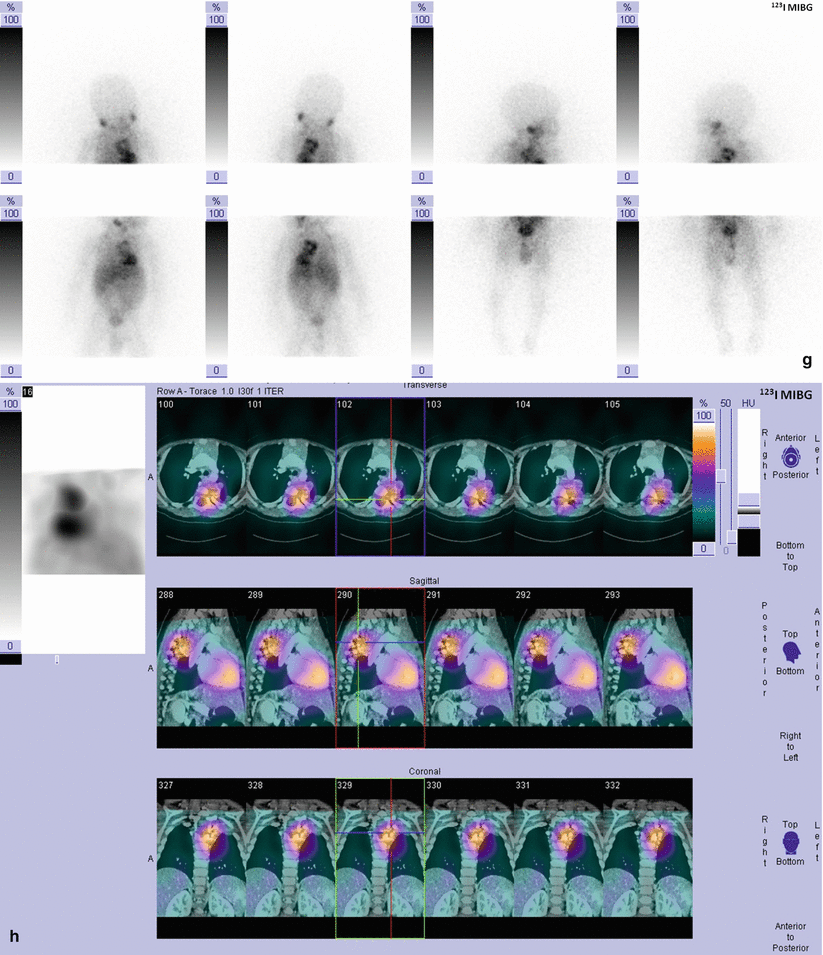


Fig. 13.3
(a–f) Transverse nonenhanced T2-weighted MR image and postcontrast T1-weighted image (a–d), and transverse and MPR coronal contrast-enhanced CT (e, f) imaging show left mediastinal mass localized at the costovertebral junction between T1 and T6 spinal levels, with foraminal and intraspinal extension (dumbbell tumor). A “contact” is present between the lesion and the aorta (aortic arch and descending aorta), the left subclavian vein, and the azygous vein, respectively. In postcontrast imaging (both CT and MRI), more than one-third of the spinal canal in the transverse plane is invaded, and the leptomeningeal spaces are not visible; the spinal cord MR signal intensity appears altered, as for marrow infiltration. (g, h) MIBG scintigraphy (static views, g) shows an area of intense and nonhomogeneous radiotracer uptake in the posterior chest; SPECT-CT fused images (h) confirm that the area of uptake corresponds to the mass detected by CT; no other areas of pathological uptake of radiotracer are evident
13.2.4 Case 13.4: MIBG Scintigraphy in Localized Abdominal Neuroblastoma
A 5-month-old baby undergoes an ultrasonography for incidental finding of abdominal swelling; US shows a solid lesion localized in the left retroperitoneal space on the middle line. CT detected a large retroperitoneal, prevertebral mass, with some calcifications (Fig. 13.4a–c), and suspected for NB, confirmed by histological examination (NB stroma poor). Subsequently, MIBG scan is scheduled for staging purpose and detects the presence of the mass without metastases (Fig. 13.4d, e).
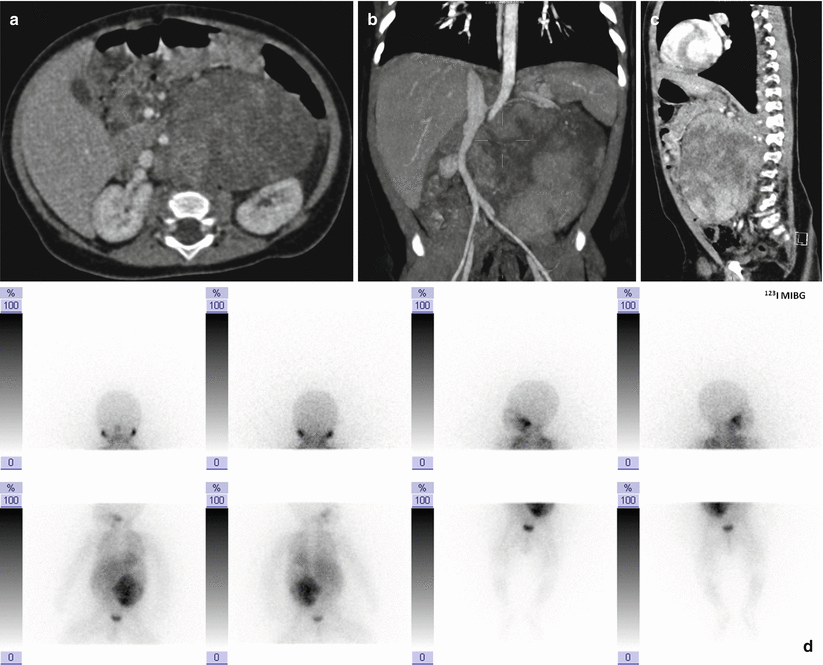
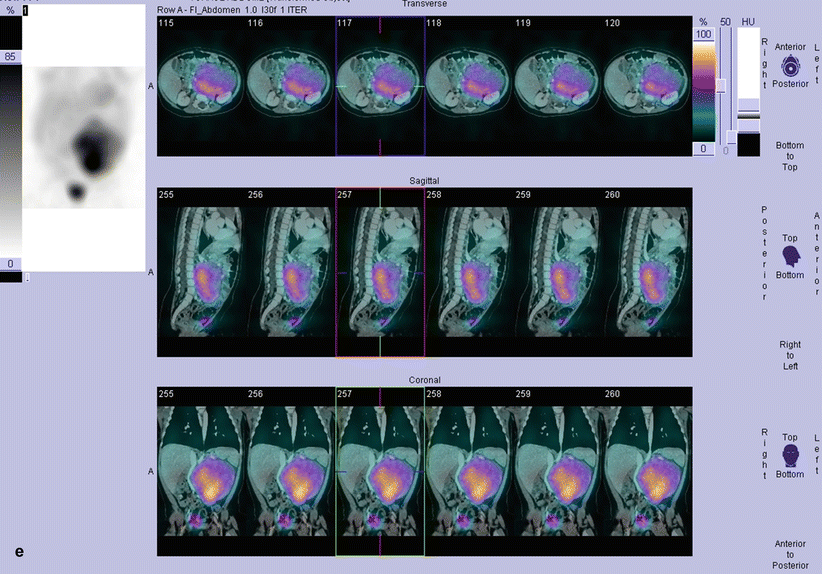


Fig. 13.4
(a–c) Contrast-enhanced CT. Transverse (a), MPR coronal (b), and sagittal (c) images show a large tumor in left abdomen, crossing the midline, containing large areas of amorphous calcifications, with nonhomogeneous enhancement after contrast media administration. Left kidney is displaced and distorted by the tumor but not infiltrated, as the normal cortex is still visible; aorta and inferior cava are pervious, although stretched, flattened, and displaced anteriorly, such as celiac artery, hepatic artery, and superior mesenteric vessels. Tumor infiltrates the iliolumbar fossa, without foraminal and intraspinal extensions. (d, e) MIBG scintigraphy (static views, d) detects a large area of intense and nonhomogeneous radiotracer uptake in abdomen-pelvis, crossing the middle line; SPECT-CT fused images (e) confirm that the area of uptake corresponds to the mass detected by CT; no other areas of pathological uptake of radiotracer are evident
Genomic profile shows the absence of numerical chromosomal aberration; so, the case is defined as L2 neuroblastoma <12 months of age at diagnosis with IDRFs – NCA genomic profile without life-threatening symptoms. Patient is enrolled in LINES protocol – Group 1 and randomized to receive chemotherapy.
13.2.5 Case 13.5: MIBG Scintigraphy in MS Neuroblastoma
A 2-month-old baby refers to our institution for vomiting and lack of appetite; an ultrasonography shows a left adrenal lesion that compresses left kidney and multiple hyperechoic areas in the liver, respectively. CT confirms ultrasonographic findings (Fig. 13.5a–f).
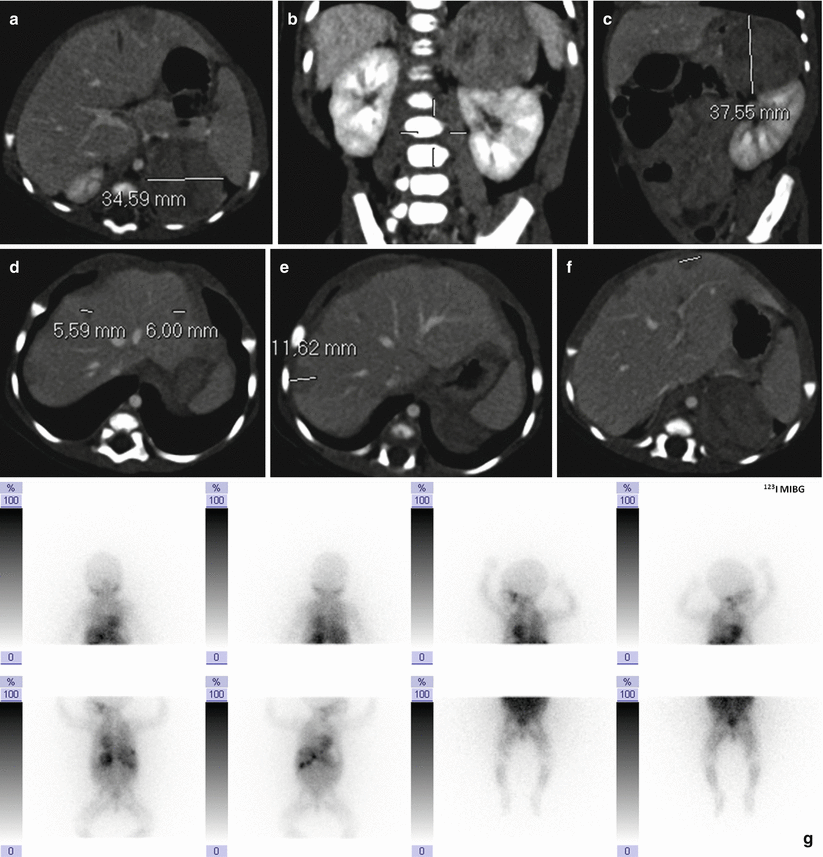
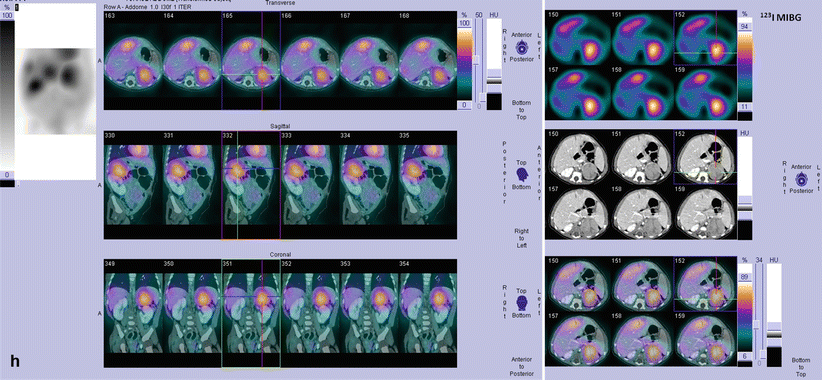


Fig. 13.5
(a–f) Contrast-enhanced CT. Transverse (a), MPR coronal (b), and sagittal (c) images show a mass in left adrenal lodge (with diameters about 41 × 35 × 38 mm); tumor appears round-shaped and well-circumscribed; it displaces and compresses left kidney, separated from the tumor by a fatty layer. The mass has a wide contact with aorta, celiac artery, and splenic vessels, stretched and flattened; a part of the left vein is completely encased by the tumor. CT scan shows also multiple peripherally enhancing lesions throughout the liver, consistent with the metastases (transverse images, d–f). (g, h) MIBG scintigraphy (static views, g) detects a large area of intense and nonhomogeneous radiotracer uptake in abdomen, in left paravertebral region; SPECT-CT fused images (h) confirm that the area of uptake corresponds to the adrenal lesion detected by CT; the liver shows nonhomogeneous radiotracer uptake, due to multiple secondary nodules evident at CT (g, h); no other areas of pathological uptake of radiotracer are evident
Histological examination reveals a NB; therefore, the baby undergoes a MIBG scan for staging purpose (Fig. 13.5g, h); scintigraphy detects the mass and a nonhomogeneous radiotracer uptake in the liver, due to the presence of metastases; no other areas of pathological uptake of radiotracer are evident.
Genomic profile shows the absence of segmental chromosomal aberration; so, the case is defined as MS neuroblastoma without SCA and without life-threatening symptoms. The patient is enrolled in LINES protocol – Study arm low-risk MS.
13.2.6 Case 13.6: Infant Stage IV Neuroblastoma: MIBG and Bone Scan Imaging Integration
A 2-month-old baby refers to our institution for appearance of multiple blue nodules on the skin; an ultrasonography shows a left adrenal mass that compresses left kidney and multiple hyperechoic areas in the liver. CT detects a prevertebral mass located in the left adrenal lodge with multiple calcification and multiple hypodense areas in the liver, respectively; several nodules are also evident in subcutaneous fat tissue of chest, abdomen, and pelvis; no lesions are evident in the skeleton (Fig. 13.6a–f). Histological examination of one of this nodules reveals a metastasis of NB; therefore, the baby undergoes a MIBG scan for staging purpose (Fig. 13.6g); scintigraphy shows a MIBG-avid mass and a nonhomogeneous radiotracer uptake in the liver, due to the presence of metastases; multiple areas of focal radiotracer uptake are evident in the abdomen, in the pelvis, and in the lower limbs (corresponding to known skin lesions).
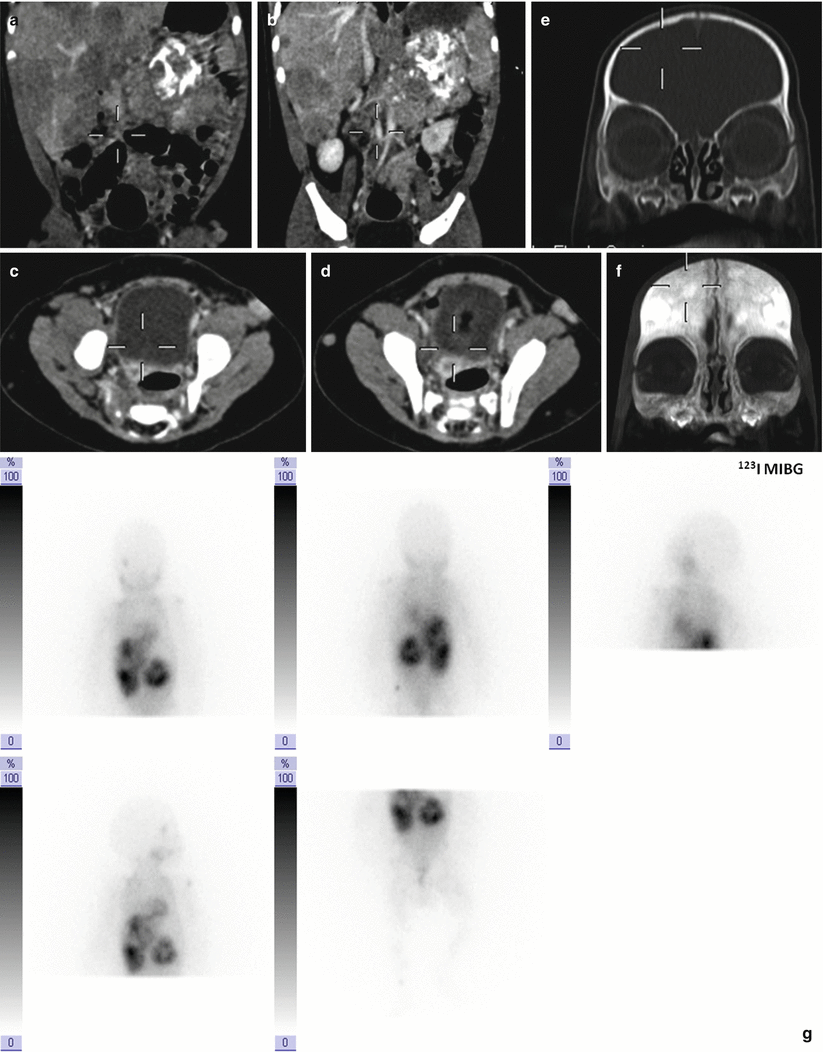
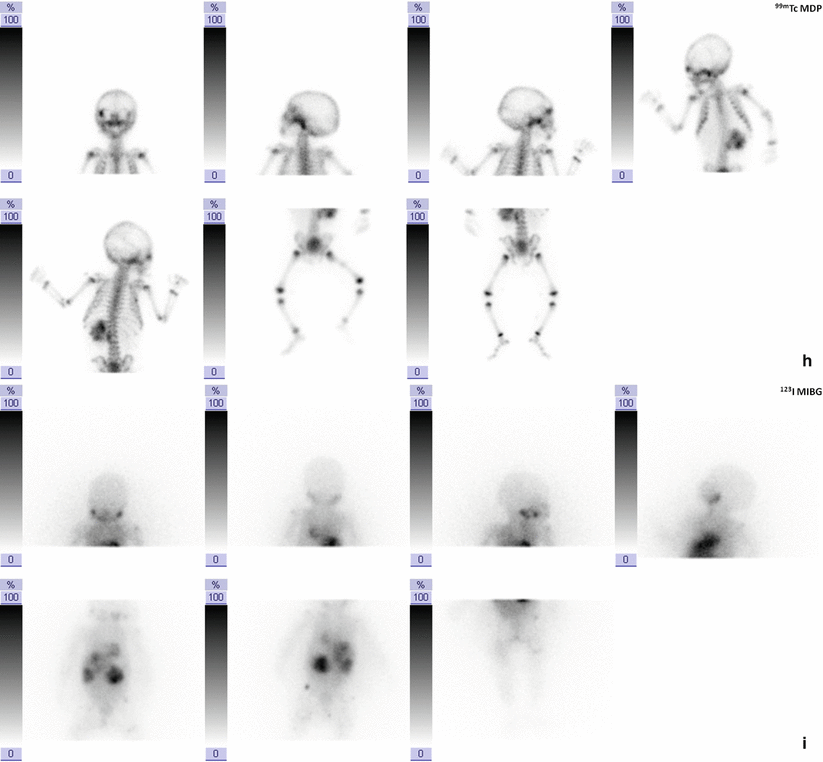
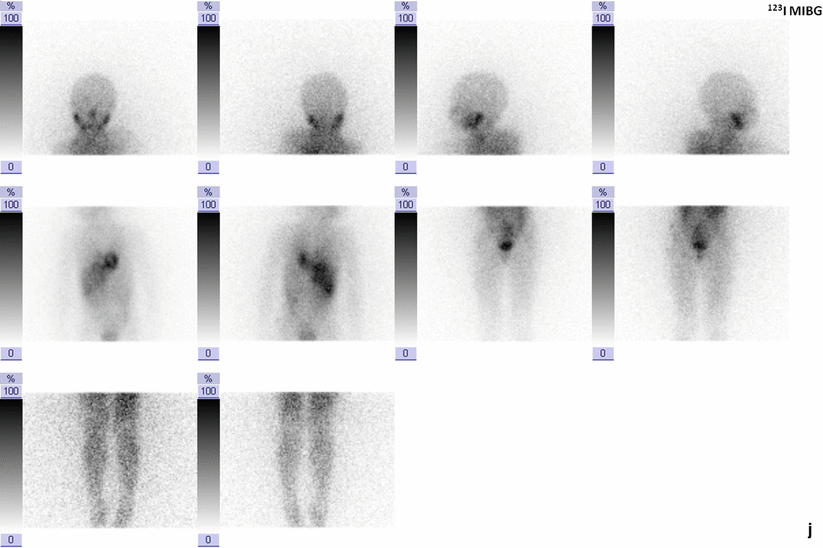



Fig. 13.6




(a–f) Contrast-enhanced CT. MPR coronal (a, b) and transverse (c, d) images show a nonhomogeneous and aggressive retroperitoneal mass containing many amorphous calcifications and located in the area of the left adrenal gland; the mass does not infiltrate the kidney and was about 40 × 35 × 48 mm in size. Many lymph node metastases, multiple subcutaneous nodules, and liver enhancing lesions are also seen. Head CT scan (e, f) does not show images consistent with metastases. (g) Staging MIBG scintigraphy (static views) detects a large area of intense and nonhomogeneous radiotracer uptake in abdomen, in left paravertebral region, corresponding to the lesion showed by CT that does not cross the middle line; the liver shows nonhomogeneous radiotracer uptake, due to multiple secondary nodules evident at CT; multiple areas of focal radiotracer uptake are evident in proximal region of left humerus, in abdomen, in the pelvis, and in lower limbs (corresponding to known skin lesions). A focal area of radiotracer uptake is evident in the right orbital region, suspected for bone metastases. (h) 99Tc-MDP bone scan (static views) shows focal uptake of radiotracer in the right orbital region, corresponding to MIBG uptake. Faint uptake is evident in known skin lesions; intense uptake of radiotracer is also evident in abdominal mass (frequent in NB, due to the presence of calcifications). (i) MIBG scintigraphy after chemotherapy (static views) shows persistence of intense radiotracer uptake in abdomen, in the primitive lesion, and of nonhomogeneous radiotracer uptake in the liver, respectively; focal uptake in known skin lesions is still present, while radiotracer uptake in right orbital region and in left proximal humerus is no longer evident, such indicating response to chemotherapy of the bone lesions. (j) MIBG scintigraphy during follow-up (static views) shows a single, very small area of faint extraskeletal radiotracer uptake in soft tissue of left iliac region (corresponding to known skin lesion) and nonhomogeneous uptake in the liver
Stay updated, free articles. Join our Telegram channel

Full access? Get Clinical Tree



